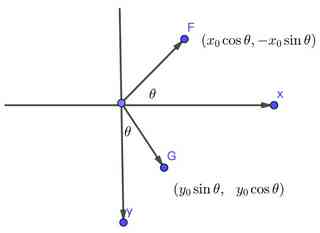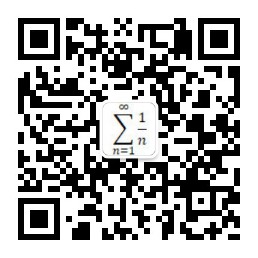仿射变换可以将矩形转换为平行四边形,可以挤压形状,但是必须保持两边平行。常见的是旋转、缩放、平移变换。缩放和平移比较简单,本文重点推导旋转缩放变换矩阵。
任意一点$(x_0,y_0)$ 可以看成$(x_0, 0)$向量和$(0,y_0)$向量相加,对$(x_0,y_0)$ 绕原点逆时针旋转$\theta$,相当于$(x_0,0),(0,y_0)$ 绕原点逆时针旋转$\theta$ 后的向量相加。
在图像处理中图片的坐标通常使用的是左手坐标系,如下图,x 轴为图片宽度方向,y轴为高度方向。

因此 $(x_0, y_0)$ 点逆时针旋转 $\theta$ 后的坐标为
\begin{align*} \begin{pmatrix} x_1 \\ y_1\\ \end{pmatrix} = (x_0 \cos \theta + y_0 \sin \theta, -x_0\sin \theta + y_0 \cos \theta) = \begin{pmatrix} \cos\theta & \sin\theta \\ -\sin\theta & \cos\theta \end{pmatrix} \begin{pmatrix} x_0 \\ y_0\\ \end{pmatrix} \end{align*}
旋转矩阵为
\begin{align*} \begin{pmatrix} \cos\theta & \sin\theta \\ -\sin\theta & \cos\theta \end{pmatrix} . \end{align*}
上面是绕原点旋转,\textbf{如果是绕任意一点旋转呢?} 假设旋转中心center为 $(c_x, c_y)$。 我们把坐标原点移动到 $(c_x, c_y)$ ,
旧坐标系任意点(x, y)在新坐标系下则为$(x-c_x, y-c_y)$。 因此在新坐标系下绕原点逆时针旋转$\theta$ ,即
\begin{align*} \begin{pmatrix} x^*\\ y^*\\ \end{pmatrix} = \begin{pmatrix} \cos\theta & \sin\theta \\ -\sin\theta & \cos\theta \end{pmatrix} \begin{pmatrix} x-c_x \\ y-c_y \\ \end{pmatrix} \end{align*}
新坐标系下旋转后的点$(x^*, y^*)$在旧坐标系下则为$(x^* + c_x, y^* + c_y)$ 。 因此旧坐标系下绕 $(c_x, c_y)$ 逆时针旋转 $\theta$ 后的点为
\begin{align*} \begin{pmatrix} x'\\ y'\\ \end{pmatrix} =& \begin{pmatrix} \cos\theta & \sin\theta \\ -\sin\theta & \cos\theta \end{pmatrix} \begin{pmatrix} x-c_x \\ y-c_y \\ \end{pmatrix} + \begin{pmatrix} c_x\\ c_y\\ \end{pmatrix} \\ =& \begin{pmatrix} \cos\theta x + \sin\theta y - c_x\cos\theta - c_y\sin\theta + c_x \\ -\sin\theta x + \cos\theta y + c_x\sin\theta - c_y\cos\theta + c_y \\ \end{pmatrix} \\ =& \begin{pmatrix} \cos\theta & \sin\theta & (1 - \cos\theta)c_x - c_y\sin\theta \\ -\sin\theta & \cos\theta & c_x\sin\theta + (1-\cos\theta)c_y \\ \end{pmatrix} \begin{pmatrix} x\\ y\\ 1\\ \end{pmatrix} \end{align*}
现在再考虑缩放,分2种情况:
(1) 旋转后以原点为中心缩放 scale, 记$scale * \cos \theta = \alpha$ , $scale * \sin \theta = \beta$ ,则
\begin{align*} \begin{pmatrix} x'\\ y'\\ \end{pmatrix} =& \begin{pmatrix} scale & 0\\ 0 & scale \end{pmatrix} \begin{pmatrix} \cos\theta & \sin\theta & (1 - \cos\theta)c_x - c_y\sin\theta \\ -\sin\theta & \cos\theta & c_x\sin\theta + (1-\cos\theta)c_y \\ \end{pmatrix} \begin{pmatrix} x\\ y\\ 1\\ \end{pmatrix} \\ =& \begin{pmatrix} \alpha & \beta & (scale - \alpha)c_x - \beta c_y \\ -\beta & \alpha & \beta c_x + (scale-\alpha)c_y \\ \end{pmatrix} \begin{pmatrix} x\\ y\\ 1\\ \end{pmatrix} \end{align*}
(2) 旋转后以$(c_x, c_y)$ 为中心点缩放,分2步: 第1步,先按上面(1)变换,此时$(c_x, c_y)$点变为了$(scale * c_x, scale * c_y)$ ;第2步 x分量平移 $c_x - scale * c_x$ ,y 分量平移$c_y - scale * c_y$。因此
\begin{align*} \begin{pmatrix} x'\\ y'\\ \end{pmatrix} =& \begin{pmatrix} \alpha & \beta & (scale - \alpha)c_x - \beta c_y \\ -\beta & \alpha & \beta c_x + (scale-\alpha)c_y \\ \end{pmatrix} \begin{pmatrix} x\\ y\\ 1\\ \end{pmatrix} + \begin{pmatrix} 0 & 0 & c_x - scale * c_x \\ 0 & 0 & c_y - scale * c_y \\ \end{pmatrix} \begin{pmatrix} x\\ y\\ 1\\ \end{pmatrix} \\ =& \begin{pmatrix} \alpha & \beta & (1 - \alpha)c_x - \beta c_y \\ -\beta & \alpha & \beta c_x + (1-\alpha)c_y \\ \end{pmatrix} \begin{pmatrix} x\\ y\\ 1\\ \end{pmatrix} \end{align*}
顺便提下,毛星云写的《OpenCV3 编程入门》旋转缩放矩阵是错的,写成了2*1矩阵;《学习OpenCV 3》中文版则有一个符号错误,把加号写成了减号。这2本书都没有推导过程,这也是我写这篇文章的原因。
晚上喝了点小酒,文本有不通顺的地方还请见谅。
